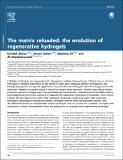The matrix reloaded: the evolution of regenerative hydrogels
Author(s)
Jabbari, Esmaiel; Leijten, Jeroen; Xu, Qiaobing; Khademhosseini, Alireza
DownloadJabbari-2016-The matrix reloaded_.pdf (1.387Mb)
PUBLISHER_CC
Publisher with Creative Commons License
Creative Commons Attribution
Terms of use
Metadata
Show full item recordAbstract
Cell-laden hydrogels can regenerate lost, damaged or malfunctioning tissues. Clinical success of such hydrogels is strongly dependent on the ability to tune their chemical, physico-mechanical, and biological properties to a specific application. In particular, mimicking the intricate arrangement of cell-interactive ligands of natural tissues is crucial to proper tissue function. Natural extracellular matrix elements represent a unique source for generating such interactions. A plethora of extracellular matrix-based approaches have been explored to augment the regenerative potential of hydrogels. These efforts include the development of matrix-like hydrogels, hydrogels containing matrix-like molecules, hydrogels containing decellularized matrix, hydrogels derived from decellularized matrix, and decellularized tissues as reimplantable matrix hydrogels. Here we review the evolution, strengths and weaknesses of these developments from the perspective of creating tissue regenerating hydrogels.
Date issued
2016-05Department
Institute for Medical Engineering and Science; Harvard University--MIT Division of Health Sciences and Technology; Massachusetts Institute of Technology. Department of Biological EngineeringJournal
Materials Today
Publisher
Elsevier
Citation
Jabbari, Esmaiel, Jeroen Leijten, Qiaobing Xu, and Ali Khademhosseini. “The Matrix Reloaded: The Evolution of Regenerative Hydrogels.” Materials Today 19, no. 4 (May 2016): 190–196.
Version: Final published version
ISSN
13697021